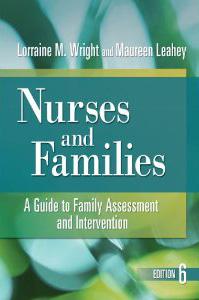 2013 marks the 6th edition of Nurses and Families: A Guide to Family Assessment and Intervention. (see www.lorrainewright.com/books for information).
2013 marks the 6th edition of Nurses and Families: A Guide to Family Assessment and Intervention. (see www.lorrainewright.com/books for information).
Over 30 years, my co-author and friend Dr Maureen Leahey and I have been strongly committed and connected to this book and its contents. However, this book seems to have taken on a life of its own as we have watched it travel the world.
Neither Maureen nor I could have imagined how far and wide the influence and adoption of this book would travel from the first edition in 1984. For that we are truly gratified and awestruck. We are very appreciative to numerous Canadian and international colleagues/students who have been so generous in their comments about the contribution that Nurses and Families has made to their teaching, practice, and research.
Initially, our book was a little ahead of its time in our family nursing community of scholars when it made its debut in 1984. There was minimal embracing of the belief that illness is a family affair and consequently there were few clinical practice models about how to best soften the suffering of families experiencing illness. Further editions of our book provided a useful road map for educators, students, and researchers to travel that exactly coincided with family centered care being taken up and espoused as an important aspect of nursing practice.
For example, CFAM was one of the four models identified in The Family Nurse: Frameworks for Practice monograph by the International Council of Nurses (Schober & Affara, 2001).
The globalization of family nursing in many corners of our world has resulted in our book being translated into 8 languages making it even more accessible (i.e. French, German, Japanese, Korean, Portuguese, Icelandic, Spanish, and Swedish).
We are also aware that various aspects of the contents of our book (e.g. CFAM, CFIM, 15 minute family interview) are utilized in nursing curricula throughout North America, Australia, Brazil, Chile, Denmark, England, Finland, Germany, Hong Kong, Iceland, Japan, Korea, New Zealand, Portugal, Qatar, Singapore, Scotland, Spain, Sweden, Taiwan, Thailand & Viet Nam.
Nurses and Families has been the primary home for the descriptions of the Calgary Family Assessment and Intervention Models. In addition, our book also describes the kind of relationship and interviewing skills necessary to soften suffering when caring for families. Since the first edition in 1984, Nurses and Families has undergone substantial embellishments with further editions in 1994, 2000, 2005, and 2009. We have enjoyed expanding each addition with the most relevant research, teaching strategies, and development of clinical practice skills.
Nurses, particularly those in acute-care hospital settings, have expressed their frustration about the substantially reduced time to attend to families’ needs and concerns because of increased caseloads, heightened acuity of patients, and short-term stays. To respect and respond to this change, we developed ideas about how to conduct a 15-minute (or less) family interview and introduced them in the third edition. Dr Janice Bell wrote an interesting editorial in the Journal of Family Nursing (2012) calling the idea of the 15 minute family interview one of those “sticky ideas” in family nursing that has taken hold in many, many contexts and countries in the world.
We have been encouraged by nurses’ reports of softened suffering by family members experiencing serious illness and enhanced health promotion with families in their care through the utilization of our clinical practice models and skills. Equally gratifying are the dedicated efforts of several nurse researchers and knowledge users examining how the clinical practice models and ideas in our book are actually taken up in practice.
In response to requests, a new chapter has been added in the 6th edition. It is: How to Move Beyond Basic Family Nursing Skills. This chapter offers nurses a clear idea of how they can enhance their knowledge and skills, especially those who have been familiar with the skills we have delineated for a number of years.
Maureen and I have also demonstrated and applied the clinical practice models and skills from Nurses and Families with actual families and have produced 8 DVD’s. Visit Family Nursing Resources www.FamilyNursingResources.com to view clips from each of these DVD’s.
What more can I say about a book that continues to have such an impact on our family nursing community and tribe? Perhaps I can simply say, “Keep on travelling Nurses and Families”. Go where you are invited, needed and continue to have your influence in clinical practice, teaching and/or research. And all the while, your co-authors will continue to marvel at your endurance, effectiveness, and tenacity.
4 Responses to “Nurses & Families: 1 Book; 2 Co-Authors; 6 editions; 8 languages; 30 years.”
expedia coupon code 2011 las vegas…
Nurses & Families: 1 Book; 2 Co-Authors; 6 editions; 8 languages; 30 years. | The Wright Perspective…
Heya i am for the first time here. I came across this board and I find It truly helpful & it helped me out much. I’m hoping to present something again and aid others like you helped me.
Someone necessarily help to make seriously posts I’d state. That is the first time I frequented your website page and up to now? I amazed with the analysis you made to make this particular publish incredible. Great job!
Excellent blog! I’ll keep keeping an eye out for more of your posts in future.